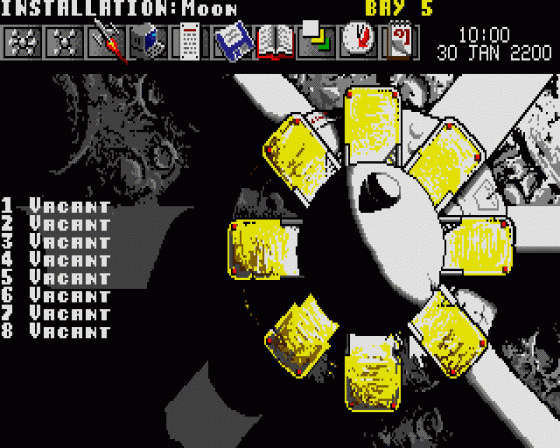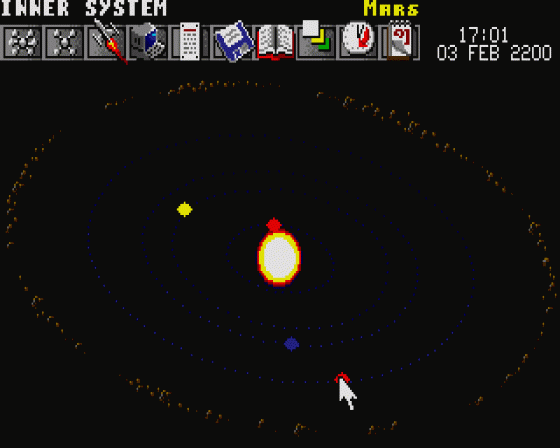
The One
 1st March 1989
1st March 1989
Categories: Review: Software
Author: Gary Whitta
Publisher: Electric Dreams
Machine: Amiga 500
Published in The One #6
The future according to Activision sees the Earth dying and fate resting in the hands of a tiny group of space colonists. Gary Whitta lends a hand...
Millennium 2.2
The year is 2200. A collision with a huge asteroid has wiped out the Earth's entire population and the planet has been rendered an uninhabitable volcanic rock. The only survivors of the disaster were a small colony of scientists based at an experimental research centre on the moon. As if this group didn't have enough trouble, a race of Martian mutants has seen the disaster as an opportunity to conquer Earth and has declared war on the hundred-odd humans holed up on the moon.
The moonbase commander has discovered that, even with the limited supplies and resources available, it may be possible to reconstruct the Earth's atmosphere so that it can, once again, sustain human life. That is, of course, if the colony can hold off the scheming Martians long enough to work out how...
Playing The Game
As the commander of the moonbase survivors, your aim is to find a way to make Earth fit for human habitation before the Martians seize the planet for themselves. Research, Production, Resources, Life Support, Defence and Energy. Each of these departments can be visited at any time, with their status displayed underneath the moonbase as either Green (running smoothly), Yellow (occupied or engaged) or Red (under threat).

Equipment can't be built without the necessary materials, so this is where the Resources facility comes into play. Raw materials are extracted from a fully-automated mine and then taken to the production centre. A great deal of power is used to run this mine, so it's a good idea to shut it down from time to time.
The Research Centre
The Research Centre is one of the most vital departments - as very little is known about any of the spaceships, equipment and transport available at the outset. Selected items are automatically investigated by your science team, with the complexity of the item dictating the amount of time taken.
Other Planets
Certain vital raw materials aren't available on the moon, so it soon becomes necessary to visit other planets in the galactic system. Following a report from a reconnaissance pod, a 'pilgrim' group of colonists is dispatched to the destination planet, together with a S.I.O.S. (a scaled-down version of your own moonbase). The new colony cannot produce equipment for itself (only the moon has a production department), so ships must be sent back and forth between the colonies.
Power-Up

Power for both the moonbase and its pilgrim stations is collected from the sun by 'Solagen' solar panels. The player starts with a single standard (Mk I) Solagen, but this can be upgraded as more materials and information become available.
When an item is selected to be built, the factory computer checks to see if it has been researched and if the necessary materials and energy are available. If everything checks out, production takes place automatically. As in the Research section, the time taken to produce the item depends on its complexity.
Mutant Colleagues!
Colonists stationed on alien worlds are liable to mutate genetically into a new species, depending on the atmosphere, temperature and other variables. Strange as it may seem, this is actually an advantage, as mutants have the added advantage of being able to live outside the base on the planet surface, and can grow without the need to update the life support system. Clever, eh?
Real-Time

Millennium 2.2 is played in real-time, with two compression options provided to speed up the action (these are necessary, as it's been estimated that the game would take more than 23 years to complete without them!). This realism extends to the galactic map, which not only accurately charts the positions of all known planets in the solar system as they would be in the year 2200, but also moves them in exactly the same orbit speed and trajectory as their real-life counterparts.
The Flight Bay
The flight bay, situated in the centre of each S.I.O.S. base can handle up to eight ships, regardless of their size or type. The most common ships are the Waverider and Carrack, used to transport minerals and equipment between the colonies, while the reconnaissance pod is a disposable device used to gather data on neighbouring planets. Each ship has a different size cargo bay (so some are better suited to courier missions than others), and requires a different sized crew.
Scaling Up
A base's life support system consists of a living quarter, supplied by oxygen and food. A basic S.I.O.S. can only sustain around 100 people, but extensions to the system ('nodules') allow the population to expand (necessary for replacing those killed in alien attacks and for crewing spaceships).
Fighting

The warmongering Martians do their best to hinder your progress. A bulletin board alerts the colony to an attack, and switches to the defence screen, where a tactical map displays the invasion fleet approaching your base. There are two types of defence with which to fend off the Martians; Orbital Lasers are computer-controlled satellites that hover in space, taking potshots at whatever comes their way, while Fighters are controlled manually.
Launching one begins an Elite-style filled-vector graphics shoot-'em-up between you and one of the Martian ships. Fighters and lasers don't come free though, and if the Martians arrive before you've built up your forces, all you can do is sit back and watch them tear your colony to shreds.
Background To The Title
Millennium 2.2 was designed and developed by Ian Bird (the man behind Activision's former strategy game High Frontier) under the title of 2200AD. That name, however, had to be changed as it was considered to be too close to the title of the sci-fi comic 2000AD.

The next name chosen was The Phoenix Factor (after Operation Phoenix, the moon colonists' plan for Earth to 'rise from the ashes' of the asteroid disaster). Even though it was a clever title, the powers that be didn't like it, and so the team at Software Studios, Activision's in-house software development team, were asked to title the game. They came up with the dubious title of F.O.M.M. (short for Fuck Off Martian Mutants) and the graphic artist even went as far as to design a commercial-quality F.O.M.M. title screen!
That title was scrapped for the obvious reason that no reputable shop would stock a game with a controversial name like that, and so at last Millennium 2.2 was chosen - effectively reverting to the original title.
ST
Carrier Command was previously the most involved and enjoyable 16-bit strategy game, and Millennium 2.2 is easily in the same league.

The design is sheer genius, and the way in which all the separate elements link together is nothing short of amazing. Learning to play takes only a couple of hours, but devising strategies that will allow you to expand your empire and maintain it could take months.
Bold decision making is the order of the day: should you scrap your last spaceship so that you can retrieve the much-needed materials for an extra Solagen? Can you afford to spare 30 of your colonists to go on a courier mission? Should you shut down your resources, mine, cutting off your vital supply of minerals so you can use the power to maintain the production line?
Make the wrong decision and you start a chain reaction that will cause your empire to collapse. And all that before you can even think about recolonising Earth! Even if it is a little slow-paced to start off with, the game's structure means that there's nearly always something to do (or worry about) and the arcade sequence provides a refreshing break from the strategy.
There are even a couple of subplots to vary the gameplay - including a killer space-virus that crops up late in the game. The whole thing is very involved, partly due to the atmospheric sound effects, and as such it's easy to "lose yourself" in the game. The graphic design is clear and uncluttered, and along with the icon/mouse control and the variety of options, helps to make the game one of the most user-friendly to date. If you're not a strategy game fan already, this is the one to convert you. Millennium 2.2 is a brilliant piece of game design and programming that can proudly take its place alongside the likes of Elite and Carrier Command.
Amiga
This version will almost certainly be identical to its ST counterpart, with minor enhancements in the music and sound effects. It should appear in March at the same price.
PC
Also available in late March at the higher price of 24.99, the PC version was the first to be developed (the game was originally text only and the graphics were only added recently). There will definitely be a CGA version, but as yet it's unclear whether EGA will also be supported.
Other Reviews Of Millennium 2.2 For The Amiga 500
Millennium 2.2 (Electric Dreams)
A review
Millenium 2.2 (Electric Dreams)
A review by Keith Campbell (Commodore User)
Other Amiga 500 Game Reviews By Gary Whitta
Scores
Atari ST Version| Graphics | 83% |
| Sound | 80% |
| Playability | 87% |
| Value For Money | 84% |
| Overall | 85% |
Scores
Amiga 500 Version| Graphics | 83% |
| Sound | 80% |
| Playability | 87% |
| Value For Money | 84% |
| Overall | 85% |















